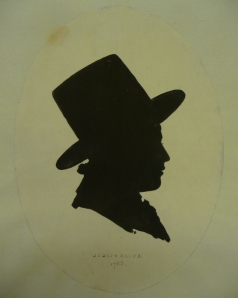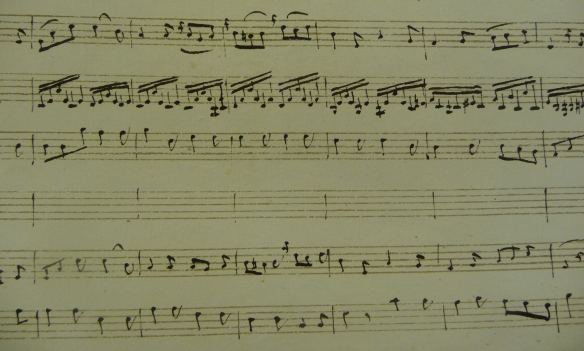« Kraus promet de devenir un des plus grands de notre monde musical. Je le préfère à Mozart à bien des égards ». Carl Philipp Emanuel Bach
 It’s amazing how many celebrities you can actually meet in a Cultural Heritage Group, – but I must confess, it takes a little imagination – and I’m not even speaking of Copernicus’ hair anymore. This morning I encountered Wolfgang Amadeus Mozart looking for one of his notebooks containing a few ideas for The Magic Flute and La Clemenza di Tito. It is the one that we preciously keep at the library and that you can discover in the exhibitions room. But I’m already sidetracking from my original idea, which wasn’t to write about Amadeus himself but rather to introduce you to another great composer commonly referred to as the “Swedish Mozart”. You may not have heard of him before if you are not an XVIII century enthusiast with an addiction to music from this period. Nobody is perfect. In reality, there are so many composers across the European nations who have been somewhat neglected and eclipsed by Salzburg’s prodigy. Joseph Martin Kraus (1756-1792), Mozart’s closest contemporary, is definitely one these composers. Although a German, he spent most of his career in Sweden. My purpose is certainly not to put the reader to sleep with an in-depth biography, but let’s just have a quick overview of his life.
It’s amazing how many celebrities you can actually meet in a Cultural Heritage Group, – but I must confess, it takes a little imagination – and I’m not even speaking of Copernicus’ hair anymore. This morning I encountered Wolfgang Amadeus Mozart looking for one of his notebooks containing a few ideas for The Magic Flute and La Clemenza di Tito. It is the one that we preciously keep at the library and that you can discover in the exhibitions room. But I’m already sidetracking from my original idea, which wasn’t to write about Amadeus himself but rather to introduce you to another great composer commonly referred to as the “Swedish Mozart”. You may not have heard of him before if you are not an XVIII century enthusiast with an addiction to music from this period. Nobody is perfect. In reality, there are so many composers across the European nations who have been somewhat neglected and eclipsed by Salzburg’s prodigy. Joseph Martin Kraus (1756-1792), Mozart’s closest contemporary, is definitely one these composers. Although a German, he spent most of his career in Sweden. My purpose is certainly not to put the reader to sleep with an in-depth biography, but let’s just have a quick overview of his life.
Kraus began to compose around the age of eight (doesn’t everyone?) and later he became, at the request of his parents, a student of law. However, soon thereafter he focused his attention fully on music and literature. Kraus was a gripping, multifaceted character who also had many interests beyond music. In 1778, at the age of twenty-one, he moved to Stockholm. His first years in the Swedish Kingdom were nothing but a life of poverty before he eventually succeeded in gaining the interest from King Gustav III : “Yesterday I was engaged by him. Of course I was not granted any great title, but quite simple that of Kapellmeister. What is worth much more to me than 600 guilders is the favor I have been granted, which is that I am to undertake a journey to Germany, France and Italy at the King’s expense ».
Kraus’s Grand Tour, which lasted four years, between 1782 and 1786, is interesting in many respects. First and foremost, a large amount of his compositions were written during these travels. His official assignment was to learn as many things as possible about the latest trends in theatre and music. It should be known that he was a prolific correspondent with his friends and family, and his letters are a vivid and remarkable testimony of the cultural life in Europe in the late XVIII century. The Grand Tour also gave him the prized opportunity to meet renowned composers such as Christoph Willibald Gluck and Joseph Haydn. And these two musicians seemed to be very impressed by Kraus’s talent. Thus, Gluck said once to the Italian composer Antonio Salieri that Kraus “has a great style”. As for Haydn, he was also very enthusiastic : « I have one of his symphonies, which I keep in remembrance of one of the greatest geniuses that I have met ». And later to add : “The symphony he wrote here in Vienna especially for me will be regarded as a masterpiece for centuries to come; believe me, there are few people who can compose something like that ». As far as I’m concerned, I’ll take the Austrian composer’s word for it.
After Kraus’s return to Sweden, he was a part of the intellectual and artistic circles in Stockholm. He died only a few months after Gustav III, for whom he wrote Cantate Funèbre and the Symphonie Funèbre, which were both played at the king’s burial ceremony.
Thanks to the Swedish diplomat and music lover Samuel Silverstolpe (1769-1851), who was also the Kraus’s earliest biographer, the Manuscript and Music section housed a very important part of the composer’s works, most of which are sheet music. Silverstolpe was also the donor of Mozart’s manuscripts. Indeed he held a post in Vienna in the 1790’s. During his stay, Mozart’s widow, Constance, gave him some real treasures that included manuscripts from her genius husband.
If Kraus is already internationally esteemed, there is still a lot to do to bring him out of the shadows. So let’s start by listening to some of his creations. I have a selection of a few of his pieces here, and remember you can also buy recordings of music from the Kraus collection at the shop of Carolina Rediviva. I wish you a tuneful musical journey!
Charlotte
Note: The two pictures are from the Kraus collection that you can consult in the special reading room.
His Requiem, one of his first work written in 1775: http://www.youtube.com/watch?v=VVEAhXbb6Yg
The superb symphony “VB 142” : https://www.youtube.com/watch?v=qg9CBBd3vZ8
A cheerful and light piece : http://www.youtube.com/watch?v=y8A0ffQWA64
One of his Opera, Aeneas in Carthago : https://www.youtube.com/watch?v=fpt-lio5oSU
In January 1792, Kraus wrote an overture, a march and interludes for the staging of Voltaire’s Olympie : https://www.youtube.com/watch?v=KzEf8nAm4MM
Kraus last work, the Symphonie Funèbre, the overwhelming drama of the murder of Gustav III : http://www.youtube.com/watch?v=iT3Go2rXb0c

